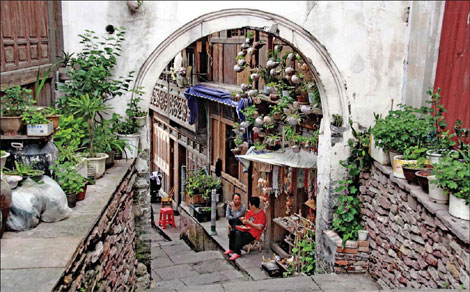Editor's Pick
The reel thing
Updated: 2011-04-22 09:54
By Lu Yi and Zhang Zixuan (China Daily European Weekly)
The picturesque ancient villages of eastern Zhejiang attract many filmmakers
 |
|
The backstreets of Shipu fishing port provided the charming backdrop |
Zhejiang province consists mostly of hills, which account for about 70 percent of its total area. The slopes ease down to beautiful valleys and plains that are nestle along the coastline and rivers. The province is traditionally known as the "Land of Fish and Rice" and it leads the nation in tea production. And Eastern Zhejiang is one of the most romantic regions of China. The idyllic corridor between the ocean and mountains has inspired moviemakers, drawn to its natural beauty and picture-postcard towns.
1. Shipu Fishing Port
The classic movie Song of the Fisherman, shot in Shipu, 1933, made the port famous. It's a colorful place, as exemplified by the traditional fishing boats that are lacquered in black and white and gaudy bars of green and red. The green on the bow is said to look like an eyebrow, hence the colloquial name of the distinctive boats from the town: "green eyebrows". The boats have three masts, which enable them to move in any direction, whatever way the wind blows.
Shipu has a quiet pace of life and typical activities include: drinking a glass of grass jelly while listening to stories told by the elderly; watching opera at the Temple of Lord Guan, and eating seafood on street corners.
"Seafood Street" in the center of the town is a popular destination, while the fishermen's canteens in Dongmen village are a lot cheaper. Dongmen is where the movie Song of the Fisherman was shot.
Shipu county is 149 km from Ningbo and there are regular buses between the towns.
2. Qiantong Ancient Town
In a house in one of Qiantong's quiet lanes is an old-fashioned barber's chair that was used in the movie, The Barber.
There's a saying that, "Rich land fosters more talent" and this perfectly describes Qiantong, which has hundreds of first class craftsmen, such as stone and wood engravers, painters, coopers, shoemakers and tailors.
There used to be more than 300 tailors in the village in 1936 and many of them later set up workshops in Shanghai, Ningbo, Taizhou and Wuhan.
As one of the larger towns on the southern reaches of the Yangtze River, Qiantong has thousands of Ming (1368-1644) and Qing (1644-1911) dynasties-style houses, ancestral halls, memorial archways and pavilions that are well preserved.
Water is still drawn by families from Bai Rivulet and walking the cobbled roads is like having a foot massage. You will often see students painting besides brooks or in front of an old house.
Ninghai Forest Spa and the Grand Canyon of East Zhejiang are also worth visiting.
Ninghai county is 85 km from Ningbo and 94 km from Shipu. Regular buses ply the route between Ninghai, Ningbo, Shipu and Qiantong.
Specials

Models gear up car sales
Beauty helps steer buyers as market accelerates.

Urban breathing space
City park at heart of industrial hub positions itself as top tourism attraction

On a roll
Auto hub Changchun also sets its sight on taking lead in railway sector